The Vetiver System – A Changing Perspective

When John Greenfield and I introduced vetiver grass hedgerows to Indian Watershed development projects in the 1980’s the objective was to replace poorly designed — high maintenance, high cost conservation structures (graded contour engineered terraces) that did not perform well either for soil conservation or rainfall loss reduction — with a low cost and effective biological system that mimicked nature – the vetiver grass contour hedge. Subsequent research in India and elsewhere generally supported the superiority of the vetiver hedgerows and its ability to reduce soil loss by as much as 90% and rainfall runoff by 70% – depending on soil and slope and at a cost of less than 1/3 of an engineered structure. Vetiver hedgerows self created natural terraces, changing the slope of land, reducing runoff velocity and redistributing it evenly, and often extending,in periods of drought, the wilting point of crop plants by 14 days or more – saving the crop. How to do all this was set out in Greenfield’s farmer’s handbook “Vetiver Grass – A Hedge Against Erosion”. Nearly 40 years later the same concept applies, a lot more research has been undertaken by reliable scientists and the results are still basically the same. …… Yet the technologies adoption has not been as fast as we would like, and the majority of tropical farmers are unaware that it even exists. There are many reasons that have contributed to the slow adoption rates, but the fundamental one is probably that small landowners/farmers had little incentive to change their land management practices, practices that have been handed down from one generation to another enabling their family survival.
…. BUT, there is change in the air because of steadily declining soil health that impacts on production and the quality of life, and the extreme weather events – flood, drought, high soil temperatures — that can have a devastating impact on food security, production, and family incomes. Farmers (especially the younger, better educated ones) are much more aware of these downsides and are looking for solutions – the solutions that may involve vetiver are not necessarily turning out to be what we think they should or might be. Farmers are looking for solutions that: reduce the use of costly fertilizer and pesticides replacing them with biological solutions involving soil microorganisms, enriched soil organic matter, reduced soil temperatures, drought and flood proofing, reduced labor for weeding, and secure food supplies. Thanks to permaculture practices and small farmer regenerative applications in Vietnam, Thailand and elsewhere that incorporate vetiver in more intimate ways, we see innovative farm/vetiver related activities that are rather different to what was being promoted in the 1980s
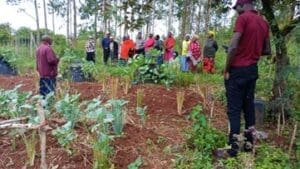
These new practices, mainly developed by farmers through their own “experimentation” puts emphasis on the symbiotic relationship between vetiver root/mycorrhiza activities and the associated crop that include soil fertility and soil moisture benefits; the utilization of vetiver biomass for mulching (soil moisture, soil temperatures), soil organic matter and carbon, and vetiver’s pest control capability as a dead end trap crop for a major pest (stem borer) of maize, sorghum, millet and rice; and the habitat it provides for biodiversity of beneficial insects that can control crop pests. Imagine, just 90 vetiver plants per ha will control stem borer in rice. A small kitchen garden with vetiver planted around its perimeter using vetiver mulch and vetiver compost, with no industrial fertilizer of pesticide, can virtually guarantee a basic vegetable/fruit supply for a rural family. Farmers are already starting to think of new vetiver linked practices/designs as shown in the following images, and are fine-tuning the layouts to suit their specific needs — all the time optimizing on the benefits that vetiver brings to the table and balancing possible revenue forgone (from land allocated to vetiver) against costs saved and added security against drought and/or flood. Other interesting development might include incorporating vetiver as a rotational crop, say for forage, that allows, after the vetiver is removed (and removal easy – cut off the crown), follow-up crops to benefit from the improved soil organic matter and microbe activity associated with the vetiver “crop” cycle. Applications as described above should make vetiver potentially attractive to flatland farmers who rarely consider, albeit wrongly, that they have a soil and water conservation problem or soil health issues.
On Farm Vetiver Design Innovations
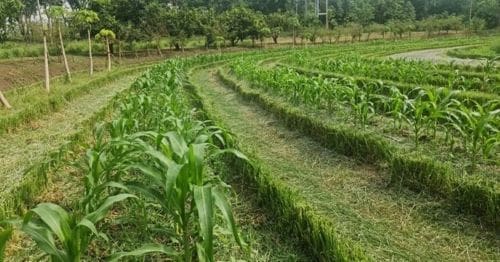
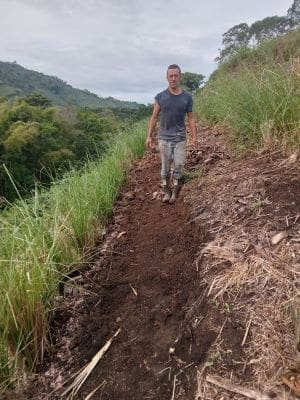



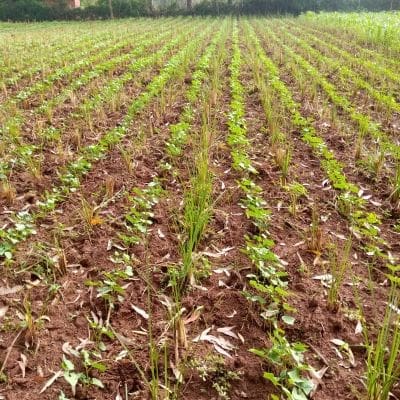
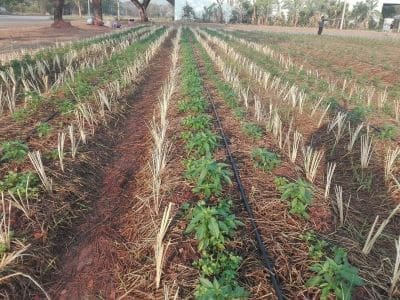
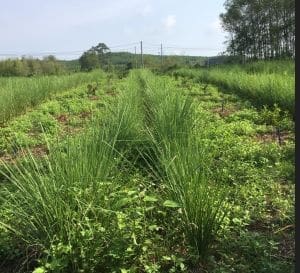

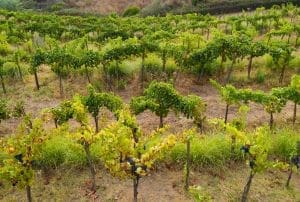
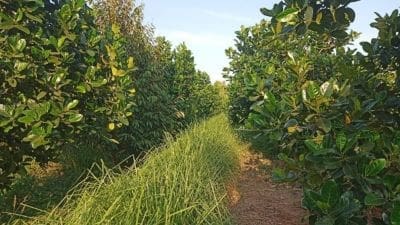
Dave Riley – Kitchen Garden Design and Views
The late Dave Riley, of Queensland, Australia was a great innovator – we miss him! Here is his layout diagram for a kitchen/vegetable garden and his rationale for doing so.
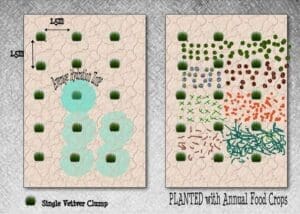
“This is the layout/design I’m experimenting with. I actually mix up the food plants rather than block plant, ast they are mainly annuals of different market garden types.
- No need for paths because Vetiver mulch protects the soil and stamping down is a regenerative agriculture principle. (So long as it isn’t heavy traffic).
- My distancing is based on Indian research in regard to clay pot irrigation. While a Vetiver clump is not as gravitationally dynamic (clay pots water rate is spread horizontally through the forces of gravity), the ability of soil to hold and permeate moisture is the key principle.
- With the soil covered with mulch, a Vetiver clump should moisten in an arc around itself depending on the atmosphere, groundwater volume, age and depth of the established Vetiver plant, and the microclimate impact of the surrounding Vetiver clumps & mulch.
- A single, established Vetiver clump would offer its own accumulated microbiological web community and carbon fill much more so than: (a) a newly planted slip, and (b) a hedge of Vetiver located at some distance from the individual food plant. Distance, I see as the problem with hedges surrounding plots.
- While you’d trim the clumps down to 30 cm and use the trimmings as mulch, clumps laid out like this would sabotage the use of machinery and may make team harvesting more difficult. However, established clumps are less likely to die if they are over-run by rambling plants like tomatoes, climbers, squashes, gourds, beans and the like. So there is that structural, trellising, element.
- Any irrigation method would primarily be deployed to sustain the Vetiver circuit and to keep moisture flow pathways open because moisture begets moisture.
- I suspect that ‘shallow’ and light irrigation as required, may do this better and more efficiently than pouring lots of water into or onto the bed. Testing or judging moisture levels in the centre of each block of Vetiver clumps before watering would make sense.
- While not a hedge, staggered Vetiver clumps like this will still serve as wind breaks and can be grown to height according to how relentless the sun may be on the food plants around each clump.
- I spent 10 years exploring clay pot irrigation methods here in the hot Australian sub tropics on sandy soil and in my schematic mind, I’m replacing each ‘pot’ of water with a living Vetiver plant while looking for BETTER results.
- Anecdotally I can say that using Vetiver this way — and growing a green mulch as required — ensures that the bed requires less irrigation input — less water effort — than the clay pot irrigation system. That’s’ pretty good when clay pot irrigation (along with wiking beds) are the most efficient irrigation systems in terms of water usage.
- So if you can keep your Vetiver alive and verdant you can grow the foods partnered around it as an intentional symbiosis.
- If I am wrong, and the clumps need to be closer to one another, then the layout won’t work because working among the clumps would be difficult and food plant growing space would be reduced too much.”
Vetiver Hedge Efficiency
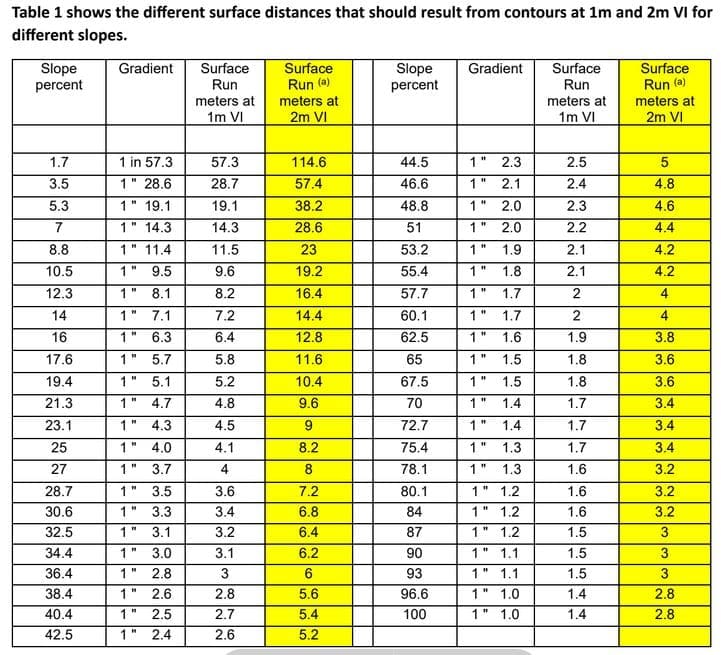
The efficiency of a vetiver hedgerow when planted for traditional soil and water conservation purposes can be significantly impacted by failure to follow the proper standards – and far too many users FAIL to follow standards. Of course, standards can be flexible, but if a user wants to optimize hedge efficiency – in other words maximize the reduction of soil loss and rainfall runoff, the spacing of vetiver plants within a hedgerow is quite critical, less so the surface run spacing – distance – between hedgerows, as this area can be effected by other conservation practices such as mulching. Even so the rule of thumb for both is 15 cm between plants and a 2m VI between hedgerows. The surface run between hedgerows using either a 2m or 1m VI as shown in table 1.
A recent study from Brazil by Michender Werison et al “Assessment of Soil Loss by a Rainfall Event on a Slope Planted with Vetiver Hedgerows at Different Spacing” compared soil loss under different spacing between hedgerows, and different inline spacing of vetiver slips on a 60% (30 degree slope) after a single one time simulated rainfall event of 50 mm/hr for 12 minutes. I converted the data to soil loss tons/ha – see Table 2 below.
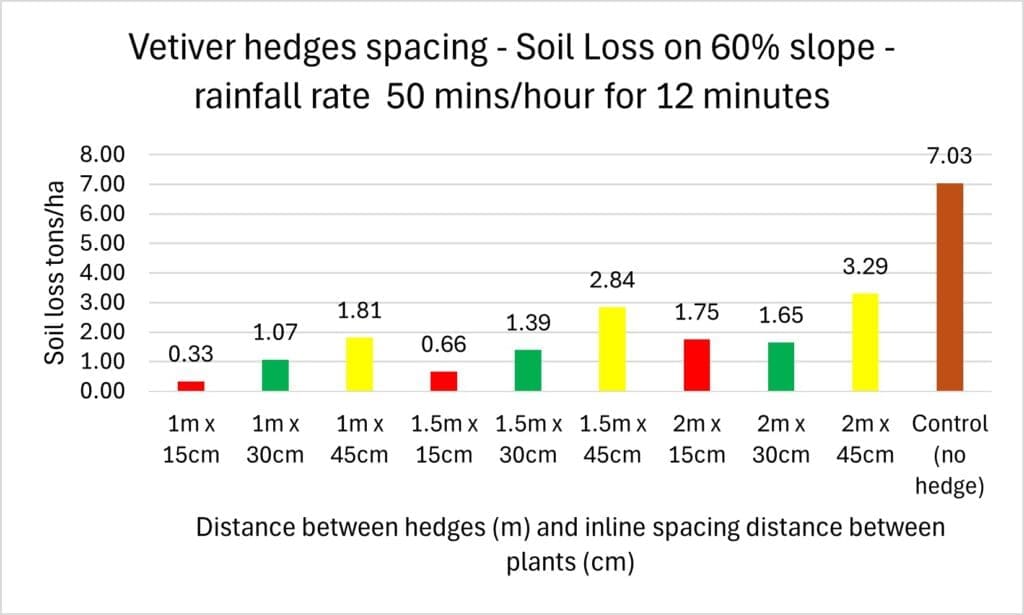
I continually raise the issue of planting vetiver hedgerows with inline spacing too far apart. This data (for a 10 month old hedges) underscores why planting distances are important, and why 15cm in-hedge planting distances are preferable. Not only does close inline spacing significantly reduces soil loss, but also it results in a better spread of rainfall runoff laterally along the hedgerow, increasing the area and retention time for infiltration, and for the better distribution of water that passes through the hedgerow to down-slope areas.
Whilst on the subject of inline (in-hedge) planting distances it is recommended that researchers agree to carry out SWC vetiver hedge experiments with a standard spacing used by all. Currently many experiments do not even mention spacing distances, nor the age of the hedgerows when experiments are carried out. Both have a significant impact on results, especially when comparing with other conservation measures.
Landscape Beautification Using Vetiver – Some Ideas From China
An overlooked and interesting paper by Hu Wenyou et al, presented at ICV7 in June 2023, titled “Vetiver System For Rural Landscaping And Countryside Beautifying” sets out the rational for using vetiver applications not only for the primary purpose of say road stabilization and SWC measures, but as both the primary and secondary use for beautification of the country side.
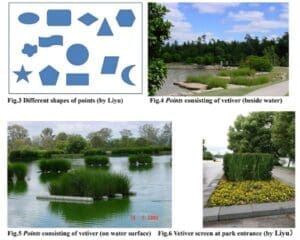
“ ….. In the recent decades following national economy reform the Chinese government and people have become increasingly interested in rural landscaping and countryside beautifying — beneficial to tourism development. Vetiver can not only control soil erosion, urban people to travel in rural areas. There are many advantages for VS for rural landscaping and countryside beautifying: protecting and stabilizing infrastructure and reduce environmental pollution, as well as strengthen landscape effects.
Vetiver grows very quickly and can be configured in many desirable shapes and patterns. As dense hedge, vetiver can strengthen natural scenic outlines …. Vetiver can be pruned several times in a year to form desirable model and formation. Vetiver can grow on soil and in water making land and water surface more attractive. Vetiver can provide variable colors to the countryside, from green in the spring to red, brown and yellow when or after flowering in autumn. In its beautification role it: reduces soil erosion; flood and landslide reduction; mitigates pollution; sequesters carbon ….. Vetiver is easy to integrate with other plants, including different crops, grasses, trees, flowers, etc., …”
Landscaping and Beautification of Urban Areas.
Some of you may recall that Alois Kennerknecht of Peru, is taking a somewhat similar approach in beautifying urban areas in Peru with a community approach. See his ICV7 paper: Vetiver Grass: Community Use in Urban Areas in Lima, Peru.
No Till, No Poison, Permanent Multi-layer Food Forest: Role of Vetiver – Food forest Development.
Vetiver has an important role to play in food forest development, particularly in the early stages before much is shaded out. Vetiver’s

primary role is to improve soil organic matter and soil moisture enabling soil micro-organisms to thrive and enabling subsequent layers of perennial plants to thrive and grow quickly. See this short article about Patanjali Jha’s Vanya Organic Farms in Madhya Pradesh, India.
Vetiver Grass Technology (VGT) as Nature-based Solution (NbS) Adaptation Technology on Guadalcanal Solomon Islands
Pacific Engage (PE), a local Solomon Island NGO, in collaboration with The Vetiver Network International undertook pilot demonstration trials at various sites on Guadalcanal, Solomon Islands. The team worked with resorts, schools, communities, farmers and individuals on the application of VGT for slope protection, riverbank protection, farm flood control and soil fertility enhancement, sanitation, ground water management, and coastal erosion control.
Nurseries were established to propagate vetiver grass for supplying communities in Guadalcanal, Isabel, Makira and Western Province.
Some of the major challenges faced by the project included disruptions caused by riots, corona virus, extreme weather – mostly rain flooding and strong winds. Lack of proper road systems and poor transport services (both land and sea).

TVNI’s Robinson Vanoh, a TVNI Board member and MD of Eagle Vetiver Systems Ltd of Papua New Guinea, engaged as a Visiting Agent (VAs are normally drawn from the private sector with a record of experience and technical expertise in quality application and management) with responsibility in advising and collaborating with Pacific Engage. One way of assuring long term viability, scale-up and continuity is to have VA agreements that extend past the project completion date thus assuring continued quality vigilance and advice. Robinson Vanoh’s performance both in the Solomon Islands and elsewhere in the Pacific Islands has been excellent. The full report with photos is available. The following summarizes the key findings of the program.
TVNI’s Robinson Vanoh, a TVNI Board member and MD of Eagle Vetiver Systems Ltd of Papua New Guinea, engaged as a Visiting Agent (VAs are normally drawn from the private sector with a record of experience and technical expertise in quality application and management) with responsibility in advising and collaborating with Pacific Engage. One way of assuring long term viability, scale-up and continuity is to have VA agreements that extend past the project completion date thus assuring continued quality vigilance and advice. Robinson Vanoh’s performance both in the Solomon Islands and elsewhere in the Pacific Islands has been excellent. The full report with photos is available. The following summarizes the key findings of the program.
Key Findings
Ecological benefits of VGT in the promotion of biodiversity and providing habitat for local flora and fauna demonsrtated at the Ruarua site where a wetland ecostystem had been destroyed by the runoff from upstream landslides. VGT, initially applied as a sediment block for marine protection, provide a micro climate enabling the development of new habitat for local flora and fauna.
Sustainable Land Management. There was strong evidence supporting VGT use for sustainable land management. With ongoing trials already benefiting land management practices. The importance of maintaining, protecting or preserving land for specific purposes is vital in sustainable land management.
Climate Change Resilience. Vetiver grass as a nature-based solution is found to be highly adaptable on Guadalcanal and other parts of Solomon Islands. There are challenges with some eco systems, but with the right technical management vetiver grass can thrive.
The effectiveness of Vetiver grass in mitigating extreme weather and other environmental challenges cannot be over emphasized. Properly applied VGT effectively prevented loss of farmland top-soil, provided flood control barriers on flood plains, prevented loss of coastal shorelines during high seas — acting as second or third line of defense, and maintaining selective ecosystems.
Sustainability. In order to achieve sustainability, vetiver grass should provide some form of business income such as the sale of vetiver slips, handicrafts, thatch or vetiver oil. To be sustainable VGT should not be standalone technology but should be integrated where possible with other economic activities, both on and off farm.
Collaboration between the South Pacific Community (SPC), the funding partner, PE and TVNI proved effective. In this program TVNI followed the practice of providing a part time Visiting Agent – highly experienced in management and VGT – to provide technical advice and quality control. This approach proved successful.
Collaboration at a national scale is important if adaptation scale up of VGT is to be achieved. A national platform can bring together NGOs, communities, businesses, government ministries.Potentials of Vetiver Grass Technology.
VGT trials empowered individuals, families and communities to deal with the above mainly weather-related challenges. Participants in this initiative were able to build defenses against sea level rise, achieve higher crop yields including fruit and vegetables. VGT enabled the expansion of land area that otherwise would not be possible using alternative expensive technical solutions.
The Way Forward
Scaling Up Vetiver Grass Technology. The proposed plan is to continue expanding vetiver nurseries to other parts of Guadalcanal and to rest of Solomon Islands, and continue with VGT where nursery suppiled vetiver stock is available The proposed Solomon Islands Vetiver Network (SIVN) is intended as a platform to facilitate the continued expansion of VGT through collaborative participation at community, local and national level fostering synergy to drive positive change through VGT applications.The proposed Vetiver Solomon Islands Limited (VSL) would facilitate commercialization activities of vetiver grass to support VGT applications in a sustainable manner.To continue advocating for increased funding and support to implement VGT on larger scales, governing structure are proposed and well-defined roles to facilitate collaboration efforts and manage the VGT adaptations in the Solomon Islands.
Capacity Building and Training — in collaboration with our technical partners the intention is to increase training, operational and planning capacity to empower local communities to apply VGT correctly to the benefit of communities. It is hoped that participation of the Visiting Agent continues.Policy Integration: To properly manage VGT as an adaptation technology the government should integrate VGT into its climate adaptations policies both at the national and local levels. Ministries such as infrastructure and forestry and environment should include VGT in their programs. …. Robinson Vanoh
Photos of Some Interesting Applications From the Regions




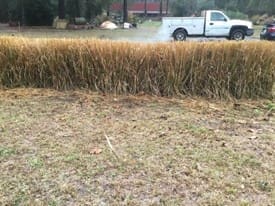
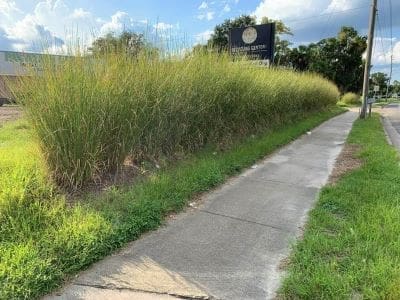
Cutting/Harvesting Vetiver Biomass
Samuel Hernandez of Puerto Rico shared this video of cutting bundles of vetiver with a chain saw and a “biomass collector”. This method has potential if you want to harvest bundles of grass for thatching or other purposes. If transportable bundles of vetiver are required, then, before removing the collector (an adjustable wire circle on the end of a pole that can be pulled tight around the circumference of the bundle) one should tie the bundle with string – like the old fashioned wheat binder that created bundles of wheat.
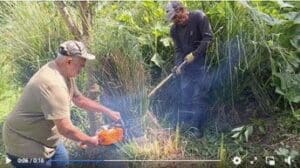


We are often asked about appropriate harvesting tools for vetiver. Of the mechanized tools a petrol powered weed-eater with a circular blade probably does the best and easiest work.
News from Ethiopia
Note from Lata Hailu — Jima Agriculture Research Center (JARC)
Vetiver grass technology is performing well in coffee farming areas. Currently, different stakeholders (agricultural offices, research centers, local NGOs, etc.) take part in the promotion of the vetiver grass system for soil and water conservation (SWC). Land degradation, due to soil erosion is a serious problem in non-coffee farm areas where free grazing and lack of awareness are challenges. Thus, we need more work to make the local community aware of and promote the vetiver grass system at the landscape level. Based on our assessment, the local community uses vetiver grass hedgerows for SWC purposes and its biomass for mulch, thatching, animal feed, etc.; however, beyond these, vetiver grass has the potential to sequester carbon in the above ground, root biomass, and soil. Furthermore, it helps reduce maize stalk borers, contributing to climate change mitigation and adaptation options. At Jima Agriculture Research Center (JARC), we are evaluating the potential of different grasses for SWC and carbon sequestration, and vetiver grass has shown outstanding results. Vetiver grass application for other uses, for instance, vetiver use for handicrafts is almost none. To promote and fully utilize vetiver grass technology, awareness creation, capacity building, and scaling up to a large scale requires more attention!!
Reflections from Vietnam
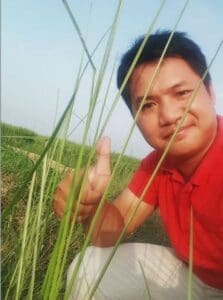
Taking advantage of nature can reduce input costs in agriculture. For example, the use of deep-rooted plants. Deep-rooted grass does a very wonderful thing. It’s a biological pump. This is not “news” in the plant world. More than 20 years ago, a group of US scientists discovered the mutual mechanism between perennial plants with deep roots and seedlings growing near them. This is a phenomenon known as “hydraulic redistribution” or “rehydration”. Accordingly, plants with deep roots will share water with seedlings so that they can overcome the dry season. In the rainy season, it helps the soil surface to drain faster and become aerated. The aeration in the rainy season will help plants avoid many diseases related to the roots, such as root rot, yellow leaves…etc. So, if applied to agriculture, how will it bring great benefits? It will help farmers use natural water, rainwater more effectively, using minerals in the soil in soluble or insoluble form is also more effective. For me this applies to vetiver species, cultivated with fruit trees and short-term trees. Vetiver grows symbiotically.
Vietnamese farmers are gradually getting used to vetiver grass on a large scale. Five years ago discussion about mulching practices was rare, now farmers see it as necessity, and planting vetiver grass is the smartest solution to maintain regular mulching.
In Vietnam, we are making a big change in the agricultural sector. Especially organic agriculture and reducing input costs. Agricultural mulch has the effects of: insulating the soil; moisturizing; nourishing microorganisms; soil structure changes; absorb more water; reducing the effects of climate change. …. We are Vietnam Vetiver Farmers Group! .. Tho Ngo
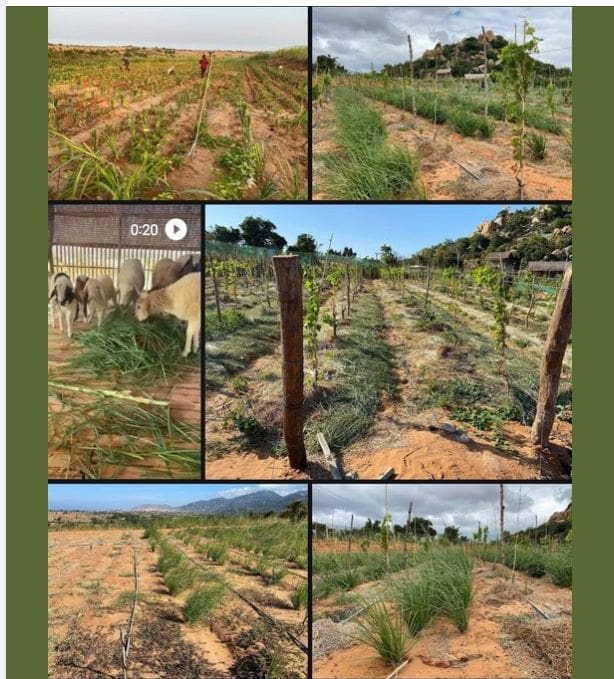
Contaminated Water Research
Coffee Related Wastewater Treatment Using Floating Pontoons and Constructed Wetlands.
Treating agriculture related polluted water is becoming increasingly important due to overuse of chemicals, intensification of livestock management, agricultural processing and related issues with heavy metal contaminated water. Here follows some research and field work relevant to mitigating these problems in the coffee sector. Due to climate change coffee production is threatened.
Use of Vetiver Grass (Chrysopogon zizanioides) in a Constructed Wetland to Remove Heavy Metals from Kege Wet Coffee Processing Plant, Dale Woreda, Sidama Regional State, Ethiopia.
by SB Yohannes et al …… located at 6°38’26.65″N 38°21’2.51″E
The effluent from the coffee processing factory can be cleaned up very well using the vetiver grass system. According to the findings, heavy metals had accumulated in roots and shoots. The vetiver grass absorbed harmful heavy metals like nickel, chromium, manganese, and copper. Based on the calculated translocation factor, the vetiver grass preferred to accumulate heavy metals in the roots. The vetiver grass system is a relatively inexpensive technology with a significant potential benefit for reducing soil contamination. Based on metal translocation and bio concentration factors, vetiver behaved as a phytostabilizer for all the heavy metals (Ca, Cu, Cr, Fe, K, Na and Zn) and efficient in translocation factor (TF > 1), of Mn and Ni from roots to shoot, serving as a good phytoextractor.
Constructed Vetiver Wetlands in Jimma, Ethiopia
Introduction Of Vetiver System In Coffee Effluent Treatment A Study Conducted At Tata Coffee Ltd, Karnataka Presented By H.R.Nagesh Rao (2013)
Removal of Pollutants From Running Water
Floating Vetiver Island (FVI) And Implication For Treatment System Design Of Polluted Running Water by F.M. Kusin et al
Abstract. Floating Vetiver Island (FVI) system has been investigated in this study as a relatively new technology of artificial wetland treatment. Vetiver grass (Vetiveria zizanioides) was used as the treatment vegetation in the FVI owing to its high tolerance to various types of contaminants. Performance of the FVI was tested on actual polluted running water having characterized by a Class III-Class IV river according to water quality index (WQI) classification. Field trial of FVI over a six-week installation demonstrated an improved water quality with significant increase (92%) of dissolved oxygen and great removals of chemical oxygen demand (77%) and nitrate (73%), resulting in 14% increase of the overall WQI. It was proposed that treatment system performance for FVI can be reflected by the number of pontoons (FVIs) and treatment distance required to achieve desired water quality improvement. The calculated pollutant removal rates were incorporated into the estimation of treatment system requirements. Field installation guide for FVI system is also presented along with treatment system maintenance. For such an FVI system, vetiver grass pruning (trimming) at 2-month intervals is recommended for promoting the growth of the plant and for medium- to long-term FVI performance.
Treatment of Arsenic Contaminated Water.
The following paper is interesting not only because vetiver appears to do the job well but it is being done in the high Andes (over 3,000m) in Ecuador under the páramo ecosystem.
Artificial Floating Island with Vetiver for Treatment of Arsenic-Contaminated Water: A Real Scale Study in High-Andean Reservoir
by Kalina Marcela Fonseca Largo et al
Abstract: Arsenic found in agriculture water reservoirs represents a threat to water security and safe agricultural products in developing countries. Small farms do not implement traditional water treatment due to the high cost; hence, a nature-based solution is an alternative to tackling this challenge. This paper investigated the potential of artificial floating island with Vetiver (AFIV) for the geogenic arsenic removal present in the reservoir of the Ilinizas páramo in Ecuador. We constructed two AFIV systems using PVC pipes in a reservoir batch type with a 3.6 m3 treatment capacity. Arsenic and iron were analyzed in duplicated every 30 days at the affluent and effluent through 120 days. The average remediation of arsenic was recorded as 97% in water and 84% in sediment, while the average remediation of iron was 87% in sediment. The survival rate of macrophytes was 92%; they accumulated arsenic in its roots that acted as a barrier against the translocation. The research demonstrated that the use of AFIV has the potential to rehabilitate reservoirs contaminated with arsenic under adverse climatic conditions such as the páramo ecosystem.
Despite the environmental conditions (over 3000m) of the study area, the results of this research shown that Vetiver is an excellent candidate for the restoration of As in water. The growth of Vetiver on the matrix floating reached a survival rate of 92%, and they established with well-developed root and shoots. The Vetiver roots acted as a barrier against As translocation, with a maximum concentration of accumulated As in the roots (494.50 mg kg−1), that was almost 7 times higher than in the shoots (71.92 mg kg−1) and nearly 16 times.
Floating Islands International Inc
This US based company has an interesting website with a wide range of applications. I believe that for some they use vetiver. I include information about this company because it does show that a vetiver service business such as this is possible, and could be extremely useful in countries such as Idia where there tens of thousands of water bodies that need cleaning up.
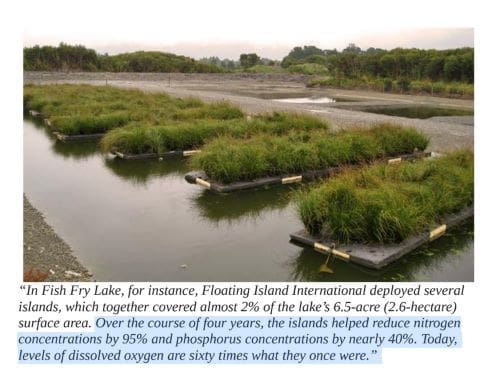
Computer model for small volume waste water treatment
This document by Paul and Nick Truong, provides some useful data on design and planning vetiver waste water treatment at small scale
Vetiver Potential for Increasing Groundwater Recharge
Conclusions of this study is that, within the headwaters areas which are normally high slope, vetiver hedgerows can be used as an effective conservation treatment in agricultural practices. The potential of vetiver hedgerows in holding water, reducing runoff and increasing groundwater recharge improve the ability of watershed to store and “deliver” water properly in quantity and timing. Vetiver hedgerows provide an alternative for watershed conservation that is somewhat similar to the function of natural forests
Modeling Ground Water Recharge Under Vetiver Hedgerows
by K Vinod Kumar
Abstract: While vetiver hedgerows have demonstrated a marked capacity for recharge of ground water, the explanation is not satisfactory. Current viewpoint is that the shoot part of the vetiver hedgerow slows down the surface flow, filters out the sediments, and diverts the flow sideways. These effects may explain part of the increased water recharge. A complete explanation of the recharge has to consider and model the subsurface architecture of vetiver, its deep dense vertical root system. In the vadose zone, hydraulic conductivity is highly dependent on the water content which in turn is dependent on the source of water like rainfall. The conventional matrix flow model, based on capillarity, is unable to explain fast recharge of ground water. Preferential flow based on films of water on macro-pores (Nimmo, J.R., 2010, Theory for Source-Responsive and Free-Surface Film Modeling of Unsaturated Flow: Vadose Zone Journal, v. 9, no. 2, p. 295-306 ) has been put forth to explain the fast recharge. The film model states that substantial water input at the surface, like rainfall or irrigation, moves down at a rapid and constant speed as films on the vertical surfaces of macro pores. At a particular three dimensional parcel of soil, the area available for film flow, the Facial Area Density, is the vertical surface of all macro-pores in the parcel. While vetiver roots may age and disintegrate to form vertical macro-pores, it is the surface of the roots themselves that provides a high Facial Area Density for regions under a vetiver hedgerow. The Facial Area Density can be related to the Root Length Density. For vetiver this surface is vertical and long. Hence the phenomenal capacity of vetiver hedgerows to increase ground water recharge can be attributed to the high vertical surface area provided by the vetiver roots for film flow. The shoot parts of the plant, start the film flow from the surface water and the myriad long vertical roots of vetiver, connected to the shoot, seamlessly transfer the water as surface film at a fast rate to the deeper regions. The film flow over the vetiver roots will be modeled qualitatively and computationally. We give a satisfactory model for the most important characteristic of vetiver- its phenomenal ability for ground water recharge.
How effective are policies in reducing the environmental impacts of agriculture?
By Hannah Ritchie –This article might interest some readers – a global prospective of policy impact
I found this article about potable water storage. It includes a discussion of the pre-Columbian Mayans using constructed wetlands. Seems similar to using floating vetiver to clean wastewater. https://hackaday.com/2024/07/02/access-to-fresh-and-potable-water-an-ancient-and-very-current-challenge/
I left a comment linking to a video demonstrating vetiver in water published by this project on YouTube.
Je suis nouveau , sur le vérifier, c’est trés intéressante comme solution d’arrêter l’érosion.
Je suis du pays du Maroc, j’ai une ferme en slop, et cette plante m’intéresse.ou, et comment pourrais-je la procurer, pour la montrer aux agriculteurs de ma région.
Merci bcp.
RIchard GRIMSHAW
Le vétiver a été introduit au Maroc dans le passé. Je vous suggère de vérifier auprès du ministère de l’Agriculture, de l’Institut botanique et de l’université. Le vétiver a peut-être été introduit comme plante aromatique pour son huile – alors renseignez-vous auprès de l’institut/de l’industrie aromatique. Voici un lien vers un rapport sur une conférence sur le vétiver à Rabat en 2006.
Thank you very much. This is extremely informative. I am new to Vetiver and see many applications in South Africa, which is currently undergoing extreme weather conditions due to climate change. I would love to know how to connect with other Vetiver growers, researchers or enthusiasts in South Africa.
RIchard GRIMSHAW
There is unfortunately no active Vetiver network in South Africa (do you want to start one?) The Godfather of VS in SA is Roley Noffke, lives near Jo’berg. His contacts are:
HydroMulch
Roley Noffke (Managing Director)
PO Box 227
Halfway House 1685
South Africa http://www.hydromulch.co.za
Tel: 27 11 318 2352
email: [email protected]
If you live in the Durban area you might be interested in visiting Maxime Robert of Vallonia Sugar Estates 29°23’0.69″S 31° 8’22.48″E … He has been using vetiver to protect his 300ha estate very successfully. I have written about his work elsewhere on our website.